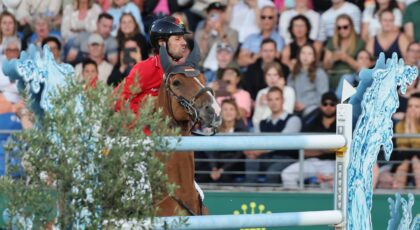They say the walk is the easiest gait to ruin, but that doesn’t mean we should avoid schooling it altogether! It can’t only be used for rest breaks for the horse and chat breaks for the rider; it isn’t a “vacation” between the trot and canter. There are a number of common problems in the walk, either because we don’t train the walk correctly, or because a horse is prone the issue from the get-go. In her bestselling book Dressage for the Not-So-Perfect Horse, 5* dressage judge Janet Foy explains how to deal with one big one: incorrect rhythm.
***
If there is some tension, you may have a few jog steps. Your horse may show a few unclear strides. There may be only a few lateral—or tending to lateral—strides. The worse case is that the rhythm becomes lateral 100 percent of the time.
If you have rhythm issues in medium walk, first check the suppleness of the topline. If the horse is stiff or tense, you have a problem. Work on many transitions from free walk to medium walk until the horse relaxes. Be sure to use your curved lines and the leg-yielding exercise. Also, walking in a bit of shoulder-in position will be helpful especially with the lateral tendency.
Walking over poles on the ground several times in your training session also helps as the horse will look down at the poles and hopefully relax and stretch his topline. Using ground poles can also help sort out rhythm problems: the horse must take the same size steps each time. It helps to improve shoulder freedom, too. If rhythm problems are caused by tension in the topline, the poles on the ground will require the horse to lower the neck, relax the back, and look down.
Remember that a long, ground-covering walk takes time—the tempo may seem slow to you. If you try to hurry a good walk, you will ruin it. When a rider tries to “push” the big walk and make it quicker, the shoulder of the horse does not have time to elevate and then step forward. So the front leg is hurried stiffly through the stride. This will cause the rhythm to be unclear, or in the worst-case scenario, lateral. Try to count the tempo of the walk slowly … 1-2-3-4. Riders who have had a horse with a short quick walk or riders with less experience will be more apt to make the mistake of hurrying.
However, if your horse is showing rhythm issues only with a true collected walk frame, but his rhythm is better with a lower, more medium walk-like frame, then by all means go for the correct rhythm. Correct rhythm is the main ingredient of dressage. The rider needs to maintain a correct rhythm—in the same tempo—to obtain the highest score. (Note: Rhythm refers to the “beats,” and the walk must have a clear four-beat rhythm. Tempo refers to the repetition of those beats, so a four-beat rhythm can be faster or slower.)
Half-steps will help with the activity of the hind legs. Most horses with a score of “9” or above in the free walk can have trouble with the walk on contact. You must be careful not to block the topline or to collect the walk too soon. When you have a problem with the walk, work on it in a shoulder-in position. Push the horse a bit sideways as you work. Make sure you are not making the walk too quick. You will get a better score with the comment “needs more march” than with a walk that has lost the correct rhythm.
Putting some ground poles (three or five or another uneven number so it doesn’t look like a jump) somewhere in your arena and walking over them several times during your workout can solve rhythm problems, too. Ground poles are also good for horses that need to lengthen the walk stride or to lower and relax the topline more.
JUDGING TIP
Novice judges often tell the rider with a “9” free walk that the walk is too slow. They see a correct rhythm, but think the tempo is too slow. Don’t listen to this advice. A “9” walk covers a lot of ground and this takes time. It may seem slow to you as a rider as well, but you must realize that you are not feeling the correct thing. Don’t hurry a big walk; you will only ruin it.
***

This excerpt from Dressage for the Not-So-Perfect Horse by Janet Foy is reprinted with permission from Trafalgar Square Books.


 March 26, 2020
March 26, 2020 

























